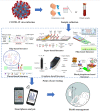Diagnostic assay and technology advancement for detecting SARS-CoV-2 infections causing the COVID-19 pandemic
- PMID: 35211785
- PMCID: PMC8872642
- DOI: 10.1007/s00216-022-03918-7
Diagnostic assay and technology advancement for detecting SARS-CoV-2 infections causing the COVID-19 pandemic
Abstract
The severe acute respiratory syndrome coronavirus 2 (SARS-CoV-2)-caused COVID-19 pandemic has transmitted to humans in practically all parts of the world, producing socio-economic turmoil. There is an urgent need for precise, fast, and affordable diagnostic testing to be widely available for detecting SARS-CoV-2 and its mutations in various phases of the disease. Early diagnosis with great precision has been achieved using real-time polymerase chain reaction (RT-PCR) and similar other molecular methods, but theseapproaches are costly and involve rigorous processes that are not easily obtainable. Conversely, immunoassays that detect a small number of antibodies have been employed for quick, low-cost tests, but their efficiency in diagnosing infected people has been restricted. The use of biosensors in the detection of SARS-CoV-2 is vital for the COVID-19 pandemic's control. This review gives an overview of COVID-19 diagnostic approaches that are currently being developed as well as nanomaterial-based biosensor technologies, to aid future technological advancement and innovation. These approaches can be integrated into point-of-care (POC) devices to quickly identify a large number of infected patients and asymptomatic carriers. The ongoing research endeavors and developments in complementary technologies will play a significant role in curbing the spread of the COVID-19 pandemic and fill the knowledge gaps in current diagnostic accuracy and capacity.
Keywords: Biosensors; COVID-19; Detection; Immunoassays; Molecularassays; SARS-CoV-2 infections.
© 2022. Springer-Verlag GmbH Germany, part of Springer Nature.
Conflict of interest statement
The author declares no competing interests.
Figures







Similar articles
-
Low-Cost Biosensor Technologies for Rapid Detection of COVID-19 and Future Pandemics.ACS Nano. 2024 Jan 23;18(3):1757-1777. doi: 10.1021/acsnano.3c01629. Epub 2024 Jan 8. ACS Nano. 2024. PMID: 38189684 Free PMC article. Review.
-
Effectiveness and cost-effectiveness of four different strategies for SARS-CoV-2 surveillance in the general population (CoV-Surv Study): a structured summary of a study protocol for a cluster-randomised, two-factorial controlled trial.Trials. 2021 Jan 8;22(1):39. doi: 10.1186/s13063-020-04982-z. Trials. 2021. PMID: 33419461 Free PMC article.
-
PCR-Free Innovative Strategies for SARS-CoV-2 Detection.Adv Healthc Mater. 2023 Oct;12(25):e2300512. doi: 10.1002/adhm.202300512. Epub 2023 Jul 25. Adv Healthc Mater. 2023. PMID: 37435997 Free PMC article. Review.
-
Rapid diagnosis of SARS-CoV-2 using potential point-of-care electrochemical immunosensor: Toward the future prospects.Int Rev Immunol. 2021;40(1-2):126-142. doi: 10.1080/08830185.2021.1872566. Epub 2021 Jan 15. Int Rev Immunol. 2021. PMID: 33448909 Review.
-
Point-of-Care Biosensor-Based Diagnosis of COVID-19 Holds Promise to Combat Current and Future Pandemics.ACS Appl Bio Mater. 2020 Nov 16;3(11):7326-7343. doi: 10.1021/acsabm.0c01083. Epub 2020 Oct 15. ACS Appl Bio Mater. 2020. PMID: 35019474
Cited by
-
A suitable drug structure for interaction with SARS-CoV-2 main protease between boceprevir, masitinib and rupintrivir; a molecular dynamics study.Arab J Chem. 2023 Sep;16(9):105051. doi: 10.1016/j.arabjc.2023.105051. Epub 2023 Jun 7. Arab J Chem. 2023. PMID: 37323221 Free PMC article.
-
Emerging Trends of Gold Nanostructures for Point-of-Care Biosensor-Based Detection of COVID-19.Mol Biotechnol. 2025 Apr;67(4):1398-1422. doi: 10.1007/s12033-024-01157-y. Epub 2024 May 4. Mol Biotechnol. 2025. PMID: 38703305 Review.
-
The potential of circulating microRNAs as novel diagnostic biomarkers of COVID-19: a systematic review and meta-analysis.BMC Infect Dis. 2024 Sep 19;24(1):1011. doi: 10.1186/s12879-024-09915-8. BMC Infect Dis. 2024. PMID: 39300343 Free PMC article.
-
Comprehensive Review of COVID-19: Epidemiology, Pathogenesis, Advancement in Diagnostic and Detection Techniques, and Post-Pandemic Treatment Strategies.Int J Mol Sci. 2024 Jul 26;25(15):8155. doi: 10.3390/ijms25158155. Int J Mol Sci. 2024. PMID: 39125722 Free PMC article. Review.
-
SARS-CoV-2 Transmission Control Measures in the Emergency Department: The Role of Rapid Antigenic Testing in Asymptomatic Subjects.Healthcare (Basel). 2022 Apr 23;10(5):790. doi: 10.3390/healthcare10050790. Healthcare (Basel). 2022. PMID: 35627926 Free PMC article.
References
-
- Gorbalenya AE, Baker SC, Baric R, Groot RJ, Drosten C, Gulyaeva AA, Haagmans BL, Lauber C, Leontovich AM, Neuman BW, Penzar D. Severe acute respiratory syndrome-related coronavirus: the species and its viruses—a statement of the Coronavirus Study Group. Nat Microbiol. 2020;5(4):536–544. doi: 10.1038/s41564-020-0695-z. - DOI - PMC - PubMed
-
- WHO https://covid19.who.int/. Accessed 23 Dec 2021
Publication types
MeSH terms
LinkOut - more resources
Full Text Sources
Other Literature Sources
Medical
Miscellaneous

